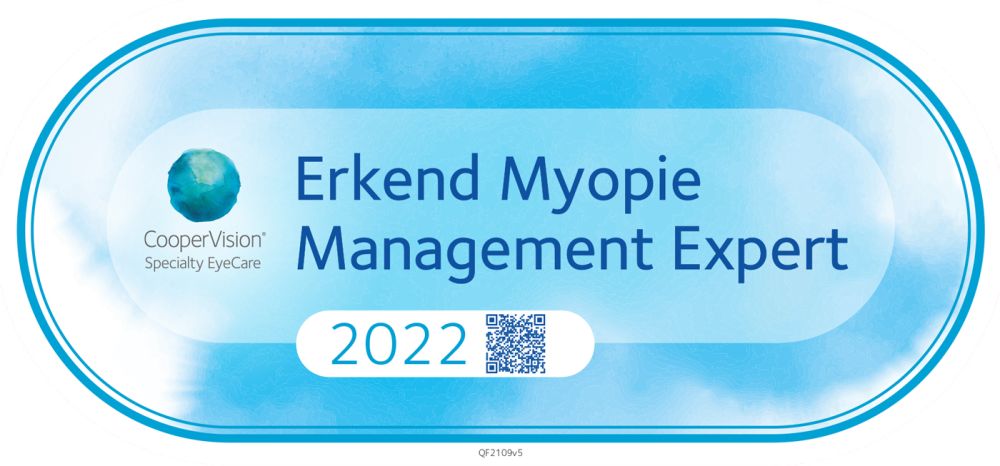Myopia in children
What is myopia or nearsightedness?
Myopia or nearsightedness is an abnormality of the eye that requires glasses or contact lenses with a minimum strength to see clearly. This is because the eyeball is too long. This causes the focus of the light rays entering the eye to fall in front of the retina instead of on it, resulting in a blurred image. An elongated eyeball (a larger axis length) is not such a problem in itself, as long as it does not grow too far. The more minus power that needs to be corrected, the longer the eye is. A very long eyeball (>25 millimeters) can cause problems later in life. Myopia is increasing rapidly among the population: a quarter of people in their sixties are nearsighted, a third of people in their forties and half of people in their twenties. At the age of 13, a quarter is already nearsighted.
What causes myopia?
Myopia is partly hereditary. But it is not the case that every child with nearsighted parents also becomes nearsighted. Lifestyle contributes to the development of myopia. A lot of reading (but also a lot of time behind screens, such as a computer or smartphone) influences the (length) growth of the eyes.
Treatment myopia
Unfortunately, there is no panacea for nearsightedness, but there are possibilities for inhibiting the length growth of the eyeball. The growth of the child’s eye takes place until the age of about 20 years, so until then influence can be exerted on the growth of the axis length. This can be done, among other things, by adjusting the lifestyle and applying the 20-20-2 rule:
• When you have looked closely for 20 minutes;
• You have to look away for 20 seconds;
• And don’t forget to go outside for at least 2 hours a day.
A lot of outside light, even when it is cloudy or raining, inhibits the length growth of the eye. Outdoor light causes the release of dopamine in the retina, which ultimately slows down the length of the eyeball.
Drops, lenses or glasses?
For children with increasing nearsightedness, there are currently various treatments to inhibit the axis length growth. This can be done through eye drops, special contact lenses or glasses. Below we explain some of these options in more detail. However, there is no treatment method to prevent myopia.
Atropine eye drops
Atropine eye drops have traditionally been used in ophthalmology. These eye drops dilate the pupil and stop the muscles that make the lens of the eye more convex in order to see up close (so-called accommodation). In recent years, atropine has also been used to inhibit increasing myopia. These drops are prescribed by the ophthalmologist. Atropine drops exist in different concentrations. Higher doses of atropine probably have a stronger inhibitory effect on the growth of the eye, but a higher concentration also gives more side effects.
Contact lenses
Special contact lenses can correct the focus of the incident light rays, so that a sharp image falls on the entire retina. This can slow the abnormal growth of the eyeball. There are currently two types of lenses available:
• Orthokeratology (Ortho-K) ‘Night lenses’
These contact lenses work like a brace for the eye. The special shape of the lens makes the cornea very subtly flatten at night, during sleep. This corrects the eye defect so that you can see clearly in the distance without lenses during the day. Ophthalmologists in the Netherlands do not recommend Ortho-K (night) contact lenses for children under 12 years of age.
• Soft Multifocal/Dual Focus lenses
These lenses are worn throughout the day and contain special rings that influence eye growth. At the same time, they ensure that vision is sharp.
These lenses can be used for the treatment of myopia from the age of 8.
Hygiene is of great importance when treating with special contact lenses to prevent infections. To avoid problems, it is therefor important to follow the instructions carefully and have your eyes checked regularly.
Glasses
Specially designed lenses are the latest option to inhibit the eye’s axis length growth. With these glasses, the central part provides a sharp image. The peripheral part of the glass contains many small plus lenses that provide delay signals in front of the retina that control the growth of the eye. A combination of atropine drops, special contact lenses and/or glasses is also possible.
Make an appointment?
The first eye examination including eye measurement and axis length measurement by our optometrist for children (from 8 years old) is free. If you want to make an appointment for this, you can reach us at 070-3461681 or info@hofstede-optiek.nl


